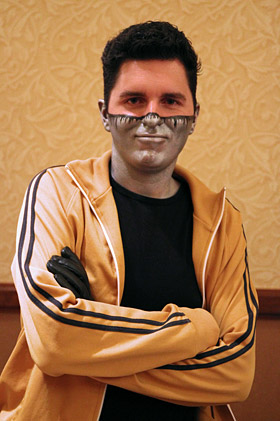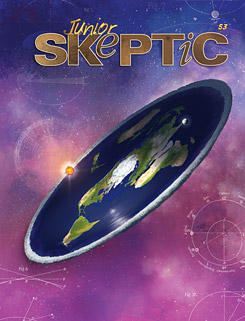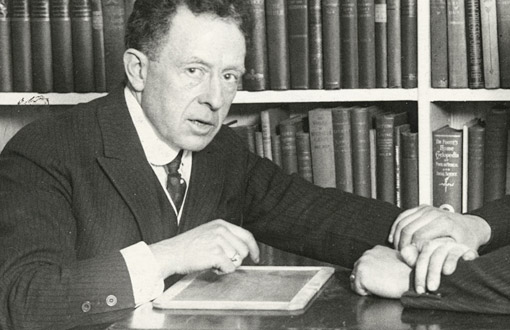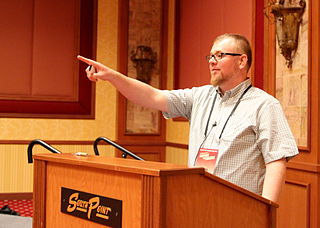Celebrating an Unbelievable Decade of Skepticality

Today marks the 10-year anniversary of the first full episode of the very first skeptical podcast, Skepticality—The Official Podcast of Skeptic Magazine (by a nose! The Skeptics’ Guide to the Universe also released their first episode 10 years ago this week—essentially simultaneously). Listen to this one-minute Skepticality teaser, released on April Fools Day. These were the first sounds ever heard in the world of skeptical podcasting. A month later, Derek Colanduno and Robynn “Swoopy” McCarthy released their first full episode, which opened with these simple words: “This is Swoopy, and you’re listening to Skepticality—brought to you on Saturday, May 7th, 2005.”
“Seriously though: Derek, Swoopy…. I owe you guys everything.”
So small, this birth of skeptical podcasting! And yet, so many things changed at that moment, as Skepticality and the Skeptics’ Guide stepped forward to show what a truly digital, grassroots skepticism could sound like, and what it could become.
Ten years, guys. It’s a helluva thing.
TAGS: Derek Colanduno, Robynn McCarthy, SkepticalityI Get Mail: Cryptids, Smoke, and Fire
In my role as the Editor of Junior Skeptic (and now INSIGHT) I quite often receive email from media, researchers, and general readers about topics I’ve covered. My schedule does not always allow me to respond in the depth I’d like, but I try to be helpful as often as I can—in keeping with the Skeptics Society‘s mission to inform the public. Today I’d like to share a pleasant exchange with an Abominable Science! reader named Karl, who wrote to ask me the following:
I have been listening to a lot of podcasts dealing with Bigfoot and Dogman and the eyewitness accounts can be compelling. Apparently, these two creatures have been seen all over the U.S. and indeed the world. There is a substantial database of accounts by now.
My question:
Do the skeptics believe that ALL of those accounts are attributable to hoaxing or mistaken identity? And if not, what are these people actually seeing?
It seems unlikely to me that ALL of these seemingly sober and earnest people, whose accounts can be vividly detailed, are either lying or mistaken in what they saw and experienced.
Here is my lightly edited reply:
TAGS: Bigfoot, cryptids, cryptozoology, eyewitness testimonyThe Masked Debunkery of Captain Disillusion!

“Captain Disillusion,” who is sometimes known by his alter ego Alan Melikdjanian. (Image by Susan Gerbic, via Wikimedia Commons. Used under Creative Commons Attribution-Share Alike 3.0 Unported license. Colors adjusted for INSIGHT.)
YouTube’s champion of video justice, Captain Disillusion (@CDisillusion on Twitter), has a new piece out this week (see below) deconstructing this compelling viral “Rush Hour” video created by filmmaker Fernando Livschitz.
As an independent skeptical activist, Captain Disillusion has long used his YouTube channel and filmmaking know-how to debunk one bit of viral video chicanery after another—from hostile penguins to preternaturally skilled ping pong to Haitian UFOs (a case I discussed myself in eSkeptic).
When the Captain took up his quirky persona and pixel-fighting mission way back in the storied yesteryear of 2007, it was already possible for artists to create seamlessly photorealistic visual effects scenes on an ordinary home computer, quickly and easily, using only a few hundred bucks worth of software. Since then, the veil of illusion has only gotten deeper and the pace of malarkey more frantic. Never have we needed our champion more!
TAGS: Captain Disillusion, viral videos, YouTubeGeorge Orwell Versus the Flat Earth

Cover of Junior Skeptic 53, bound inside Skeptic Vol. 19, No. 4. Subscribe to Skeptic
In recent months I’ve been hard at work on a three-part series of Junior Skeptic articles exploring fringe theories regarding the shape of the Earth. The issue on newsstands now considers the peculiar history of claims that our world is as flat as a pancake. Our upcoming issue considers the (surprisingly) much more reputable history of hollow-Earth thinking through to the end of the 19th century. To complete the series, I am working now on an issue about 20th century hollow-Earth beliefs with their frankly creepy intersections with conspiracy theories, flying saucers, Nazis, and madness. (Subscribe to Skeptic here.)
These stories about radically distorted Earths are a lot of fun to research, and to tell, because of the tension between the preposterousness of these ideas and the sincerity, slipperiness and passion of the arguments used to support them. To look inside such beliefs is to visit alien worlds. And when on such strange journeys, there are few things more intriguing than trail-markers which tell us people we recognize have, like Arne Saknussemm, passed this way before.
I adore the 10-page Junior Skeptic format, but the limited space and young audience do often force me to leave wonderful tangential material on the cutting room floor. One of the most painful of those cuts from the story of the Flat Earth? Once upon a time, this topic was tackled by the author of Animal Farm and Nineteen Eighty-Four.
TAGS: flat earth, George Bernard Shaw, George Orwell, Junior SkepticGotcha! Thinking About Skeptical “Stings”
In my last post I outlined a small recent stir caused by sharp comments about skeptics from former Ghost Hunters cast member Amy Bruni. I promised to dig further into the issues of skeptical undercover work and “sting”-type traps designed either to expose the roots of claims or, in the most striking cases, to catch charlatans red-handed.
These tactics can be extremely hard hitting, when they hit their mark. A well-known case involving both deceptive undercover work and a shocking reveal is “Project Alpha,” organized by James Randi. Under his direction, teenaged magicians Steve “Banachek” Shaw and Michael Edwards posed as psychics in a laboratory setting, where they successfully bamboozled parapsychological researchers. When the skeptical conspirators eventually held a press conference and revealed their years of deception (video), the world was compelled to consider parapsychology’s vulnerability to fraud. The ripples from that hoax are still being felt, as Randi’s contemporary Ray Hyman predicted more than 30 years ago: “There’s going to be an argument from now until doomsday about what the whole thing showed.” Another classic example of a skeptical sting is the operation which severely set back the profitable faith healing career of Peter Popoff in 1986 (also spearheaded by Randi, in collaboration with the Houston Society to Oppose Pseudoscience, the Society of American Magicians, and the Bay Area Skeptics). The televised exposure of Popoff’s secret use of “miraculous” information relayed by radio surely stands one of the greatest “gotcha” moments of all time (video).
TAGS: deception, ethics, skeptical history, stings, undercover investigationConsidering a Complaint About Skeptical Tactics
Few skeptical tactics are as hard-hitting or as ethically fraught as undercover investigation and “sting”-type traps designed to expose the roots of too-good-to-be-true claims—or even to catch tricksters red-handed. A recurring controversy over those tactics has flared up again over the last few days, following some sharp remarks about skeptics from former Ghost Hunters cast member Amy Bruni. Bruni took to her Facebook Page to express her frustration with skeptics who engage in such tactics, presumably in reaction to two recent sting attempts (dubbed “Operation Bumblebee” and “Operation Ice Cream Cone” by organizer Susan Gerbic). Bruni wrote:
TAGS: Amy Bruni, deception, ethics, stings, undercoverWeird…I don’t see people who believe in paranormal and psychic phenomena accosting “skeptics” at their conventions and gatherings—or posting constant blogs and forums about how skepticism is terrible. Strangely enough, we really don’t care what their belief system is—because it is their right. And personally, I don’t care or have to justify what I believe to someone else.
So, why do they feel the need to constantly bash what we do? Arrange “guerrilla stings” on psychics and paranormal conventions? I mean—puh-lease, you must have something better to do.
Truly—there’s a whole lot of bad in this world. And if your “cause” is to take on people whose thoughts on life and existence are different from yours, (but causing YOU no harm), I think it’s time you take a little look at yourself.
Make a real difference with the time you have. Volunteer at an animal shelter, join Big Brothers/Big Sisters, serve food at your local soup kitchen…the list goes on.
Because I have news for you—none of us kooky paranormal folks need saving.
Book Review: The Big Golden Book of Dinosaurs
The Big Golden Book of Dinosaurs, by Robert T. Bakker, illustrated by Luis V. Rey (New York: Golden Books, 2013); 64 pages; reviewed by Daniel Loxton.
This review also appears in the current January–February 2015 issue of the Reports of the National Center for Science Education (Vol. 35, No. 1). See the table of contents, or download a PDF copy of this article here.

The Big Golden Book of Dinosaurs, by Robert T Bakker, illustrated by Luis V Rey
I’ve always loved books about prehistoric animals. Nothing brings back the glow and wonder of childhood like opening my dog-eared, loose-paged copies of Golden Books’ 1977 Dinosaurs, with its old-school tail-dragging creatures painted by legendary fantasy artists Tim and Greg Hildebrandt, or Happytime Books’ 1979 Dinosaurs, lovingly illustrated by Bernard Herbert Robinson—and lovingly inscribed “This book belongs to Danny” on the frontispiece. I spent more happy hours with those books than I could possibly tell you, curled up on my grandma’s couch. Did it matter that the animals were often inaccurate even by the standards of the time, or sometimes mislabeled altogether? Did I love such books less for presenting the whole of the geologic past as a jumbled Lost World where Jurassic Stegosaurus might have challenged Cretaceous T. rex, or perhaps even have grazed beside mammoths? Of course not—but with better books I might have loved these vanished creatures in deeper, truer ways.
TAGS: dinosaurs, education, evolution, Luis V. Rey, paleoart, review, Robert T. BakkerSkeptic David Morrison Receives AAS Education Prize

David Morrison. Image courtesy NASA Ames Research Center
Many congratulations are due to astronomer and skeptic David Morrison, named as the recipient of the 2015 Education Prize from the American Astronomical Society (AAS) at their 225th semiannual meeting held January 4–8, 2015 in Seattle, Washington. The AAS is North America’s major organization of professional astronomers.
TAGS: award, David Morrison, educationThings Skeptics Knew a Century Ago About How Thinking Goes Wrong

American psychologist and skeptic Joseph Jastrow. Image courtesy US National Library of Medicine, via Wikimedia Commons.
When better than the final days of the year to reflect on lessons of the past? Today, I’d like to share a small selection of quotes, each written over a century ago, which seem to me to bring the skepticism of our time and that of previous generations into a thought-provoking resonance. These passages employ concepts and jargon that are frequently used by skeptics today. This may strike us as prescient; however, I would argue that this apparent prescience is largely an illusory artifact of our own forgetfulness. In any event, these are a tiny sampling of conversations which were current in skepticism long before any of us were born.
I invite you to gaze into these passages, and reflect for a moment that in some ways the conceptual tools for skeptical examination of paranormal claims have changed little more in a century than the nature of imposture and superstition.
TAGS: David Phelps Abbott, expectant attention, inattentional blindness, Joseph Jastrow, Michel-Eugene Chevreul, placebo effect, PT Barnum, skeptical history, William Benjamin CarpenterThe Forgetfulness of Skepticism

Skeptic Joseph Rinn, demonstrating mediumistic trickery for a press syndicate in 1920. (From Daniel Loxton’s collection.)
Scientific skepticism has a long history—roughly 40 years in its most modern organized form, and centuries (arguably millennia) as a more or less recognizable tradition. (See my “Why Is There a Skeptical Movement?” for a discussion of this lengthy intellectual thread—PDF.)
We’ve learned a lot in that time. Generations of skeptics have devoted themselves to understanding paranormal and pseudoscientific claims, beliefs, and impostures. But even with those efforts, the fringe has remained radically under-examinded. Because this realm is so vast while the scholars and activists interested in exploring it are so few, our work has often had something of a scrambling quality. In our rush, skeptics have tended to neglect, or at least to set aside for some future time, some of the improvements of better-established fields.
TAGS: Carl Sagan, exceptionalismism, Joseph Rinn, skeptical historyVideo: TAM 2013 Skeptical History Workshop

Daniel Loxton at TAM 2013 “Preserving Skeptical History” workshop. Photograph by Susan Gerbic, via Wikimedia Commons. Used under Creative Commons Attribution-Share Alike 3.0 Unported license.
The James Randi Educational Foundation (JREF) is continuing to move video content from their “The Amazing Meeting 2013” conference onto YouTube. I was very excited that year to put together a workshop on a topic roughly one thousand times more fascinating than it sounds: “Preserving Skeptical History.” I was joined by INSIGHT’s own Tim Farley, Robert Sheaffer (leading UFO skeptic and Skeptical Inquirer columnist since 1977), and Susan Gerbic (of the Guerrilla Skepticism on Wikipedia project). We also enjoyed, as a special honor, the participation of psychologist Ray Hyman—leading parapsychology-critic and co-founder of the modern skeptical movement.
As organizer, I took the liberty of introducing the workshop with some remarks about the value of historical approaches within skepticism, the text of which I published at Skepticblog under the title “Should Scientific Skeptics Care About History?” I then segued into a practical discussion of historical sleuthing, including such topics as finding rare sources on no budget and the unwelcome news that microfilm is still a thing. This portion may be of interest to teachers, students, and grassroots skeptics.
TAGS: Daniel Loxton, history, Ray Hyman, Robert Sheaffer, skeptical history, Susan Gerbic, The Amazing Meeting, Tim FarleySome of My Work in Skeptical History (Updated)
A version of this post was originally published at Skepticblog on August 19, 2013, where I intended to update it from time to time. However, the Skeptics Society has since retired Skepticblog, so the original post—which remains available—is no longer suitable for updates.
As I have a couple of newer items to add, and expect to have others to add in the future, I thought it might be useful to publish a lightly updated version here at INSIGHT.
Advocating for the importance of skeptical scholarship is a bit of a theme for me—the scholarship practiced by skeptics, and also scholarship about skepticism. In particular, I’ve devoted quite a bit of attention to the exploration of the history of (“scientific”) skepticism. Historical reflection has become a larger ongoing concern that unifies much of my work.
With that in mind, I thought it might be useful to collect, list, and link to some of my work relating to the history of skepticism. I hope to update this post with new links as time goes by.
You’ll forgive me if my criteria for including or excluding this or that content under the heading of “skeptical history” is a bit loosey-goosey. The history of skepticism and the history of fringe science and paranormal claims are closely interrelated. I write about both (my book with Don Prothero, Abominable Science! belongs to the latter category) but for our purposes here I am specifically interested in the internal history of skeptics and skepticism—the history of critical investigation of paranormal claims. I’ve selected a few examples of my work that seem to speak to that topic:
CONTINUE READING THIS POST…
From the Skeptical Literature: Thomas Ady on the Role of Mental Illness in Witchcraft Confessions (1655)
Thomas Ady was an English doctor and critical exposer of both persecutions for alleged witchcraft and the type of faux-paranormal scams, such as fortunetelling, that sometimes led to witchcraft trials. He was especially critical of the use of torture (including sleep deprivation1) in those trials. But some victims of witch trials confessed without coercion. Ady reflected on those poor souls as follows:
TAGS: Candle in the Dark, Carl Sagan, skeptical history, Thomas Ady, witch hunting, witchcraftSome indeed have in a melancholly distraction of minde confessed voluntarily, yea and accused themselves to bee Witches, that could do, and had done such strange things, and wonders by the help of the Devil; but mark well their distemper, and you shall finde that they are deeply gone by infirmity of body affecting the minde, whereby they conceit such things as never were, or can be, as is often proved by experience among Physicians, many of those dying in a very short time, (although they be not put to death) except they be cured by the Physician; and truly if such Doctrins had not been taught to such people formerly, their melancholly distempers had not had any such objects to work upon, but who shall at last answer for their confession, but they that have infected the mindes of common people with such devillish doctrins, whereby some are instigated to accuse their poor Neighbours of impossibilities contrary to the Scriptures, and some drawn to confess lyes, and impossibilities contrary to Christian light?
Video: TAM 2013 Panel on the Scope and Mission of Scientific Skepticism

Steven Novella, Daniel Loxton, Barbara Drescher, and Jamy Ian Swiss sitting on the “Skeptical Scope and Mission” panel discussion at The Amazing Meeting 2013 conference (July 11–14, 2013) in Las Vegas.
The James Randi Educational Foundation (JREF) has begun to move video content from their Amazing Meeting 2013 conference onto YouTube.
I was honored that year to join in a panel discussion with magician Jamy Ian Swiss, Skeptics’ Guide to the Universe host Steven Novella, and INSIGHT’s own Barbara Drescher, with Doubtful News creator Sharon Hill serving as moderator. The topic—the question of the “scope” of scientific skepticism—was an old one. But the conversation that emerged on stage may (in my opinion) be one of the most serious, positive, and forward-looking discussions this topic has received in years.
I was tremendously gladdened by that. I’ve often written about the focus, utility, and moral value of scientific skepticism. See for example my 2007 op-ed “Where Do We Go From Here?” (PDF), 2013 historical exploration “Why Is There a Skeptical Movement?” (PDF), or my 2014 speech “A Rare and Beautiful Thing” (read the text or watch the video).
It’s important to me. Important personally.
TAGS: Barbara Drescher, Daniel Loxton, Jamy Ian Swiss, scope of skepticism, Sharon Hill, Steve Novella, The Amazing MeetingINSIGHT at Skeptic.com: Comment Policy
There are few things so central to the projects of scholarly, journalistic, and scientific truth-seeking than conversation. Talking things out is humanity’s greatest superpower. It is the true telepathy—a way for one mind to reach out and attempt to understand another.
With the fruitful alchemy of conversation in mind, we’re pleased to allow comments on most posts at INSIGHT at Skeptic.com. We invite and encourage civil discussion, scholarly debate, and open exchanges of ideas.
To that end, comments on blog posts at Skeptic.com are moderated, and should be considered a privilege. If you choose to submit comments, please remember:
- Comments should be polite, charitable, on-topic, and reasonable.
- Comments should not be abusive, disruptive, libelous, annoying, or spam.
- Comments judged to be inappropriate will be deleted. Commenters who abuse the comments policy in any manner may be banned.
- Commenters are encouraged (though not required) to engage in discussion under their own names.
Welcome to INSIGHT at Skeptic.com
Hello! I’d like to welcome you to the Skeptics Society’s new group blog dedicated to science and skepticism, INSIGHT at Skeptic.com. This brand new platform will feature news, commentary, and informed perspective regarding fringe claims, paranormal mysteries, mainstream science, and the ethos and history of skepticism itself.
Joining me in this new venture are some of the most passionate and knowledgable voices to speak within the tradition of scientific skepticism today:
- Ani Aharonian, a cognitive psychologist and PhD student at the University of Nebraska, Lincoln, and an institutional researcher at Santa Monica College;
- Barbara Drescher, a long-time former university instructor of quantitative and cognitive psychology, blogger at ICBS Everywhere, regular contributor to the podcast Skepticality and the weekly streaming video program The Virtual Skeptics;
- Tim Farley, a computer security analyst, creator of the What’s the Harm? website and the Skeptical Software Tools blog, and co-host of The Virtual Skeptics;
- Jim Lippard, a skeptical writer for decades who works in the information security field, blogger, a founder of the Phoenix Skeptics (in 1985), and a founding member of the Phoenix Area Skeptics Society (in 2012);
- Robynn “Swoopy” McCarthy, the founding co-host of the pioneering, original skeptics podcast, Skepticality—The Official Podcast of Skeptic Magazine;
- Mike McRae, an Australian educator, science writer, and author of Tribal Science;
- Dr. Donald Prothero, a paleontologist who has taught college geology and paleontology for decades at schools including Caltech and Columbia, and author of over 35 science books (and over 300 scientific papers);
- Dr. Michael Shermer, a Scientific American columnist, historian, author of numerous books, and Editor and founding publisher of Skeptic magazine;
- Dr. Eve Siebert, a blogger at Skeptical Humanities and co-host of The Virtual Skeptics;
- Blake Smith, the producer and host of MonsterTalk, an official podcast of Skeptic magazine;
- Laurie Tarr, a technical writer and co-founder of the Louisville Area Skeptics;
- and finally, yours truly.










